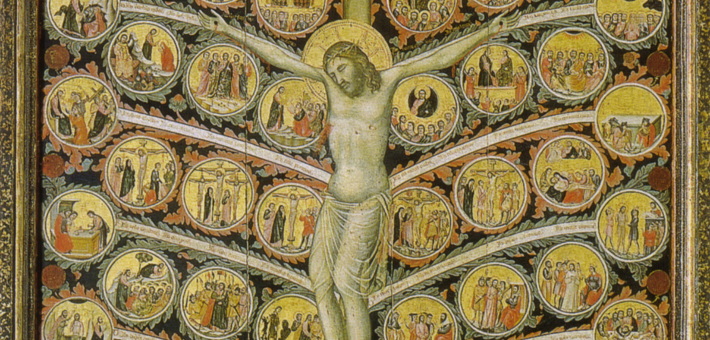Commentary on Isaiah 52:13—53:12
Dawn comes while shadows still linger in the sky, and I realize there is no whole picture without light and darkness. The picture of the “Suffering Servant” in this Isaiah text is sketched with bright stripes of self-sacrifice, commitment, and purpose, and dark strokes of abuse, humiliation, torture, and death.
Isaiah 52:13–53:12, the fourth of the Servant Songs, shows how goodness interlocks with injustice, and how whether we like or not, for the time being, both coexist in our midst. The text is used during Holy Week referring to the suffering and passion of Jesus.1 Interpreted as an individual who suffers innocently on behalf of others, but also as Israel’s collective ideal role model of sacrificial servanthood, the “servant” is a nameless figure who delivers Israel and transforms the world.2
The first section (Isaiah 52:13–15) introduces the servant’s wisdom, insight, and understanding, his exaltation and disconcerting impact.3 The second section (Isaiah 53:1–12), with a sober and dark atmosphere, details his rejection, suffering, and victory. Both sections are interwoven with repeating images and verbs associated with this outcast and afflicted figure (52:13; 53:11b).4 The passage also shines brightly with the servant’s determination and willingness to serve and to uphold his people, no matter the cost.
The servant’s capacity for understanding is central (52:13) and points out the ability to make sound judgment, based on a deeper analysis of reality, helping the servant to identify the motives of people and systems. But also, one must understand and accept the risks when seeking the well-being of the people.5 Although the servant is the “arm of the Lord,” his description is prone to produce repulsion. His unpleasant appearance (52:14; 53:2) is intensified by his low worth, insignificant presence, and submissiveness (53:6–7). People will not be attracted to him for worldly reasons like wealth, honor, power, success, or beauty. Instead, they are shocked by his lack of all these things (52:15).6
The theme of humiliation in Isaiah 50:4–9a is repeated here. Parallel to people abused, criticized, and robbed of their dignity, the servant portrays the gloomy image of the loser, the one all people despise and reject. The writer, like the exiled Israel (verses 3–4), is sick and in pain as someone smitten by disease, and carries such intense shame that he forces others to look away.7
In ancient Israelite society, guilt was understood not only as a personal or psychological state but also as a communal and covenantal issue. The guilt offering (Leviticus 5:14–19) was a crucial part of the sacrificial system, designed to restore the relationship between the offender and God, as well as between the offender and the community. A series of verbs and images develops the concept of sacrificial substitution, which becomes the way of this servant. The notion of bearing, lifting, or removing sin, expressed with the verb nasa’ (52:13; 53:4), includes accepting the responsibility or guilt, whereas forgiveness becomes the act that removes that burden. Consequently, the servant sprinkles his life in a cleansing act of atonement, embracing all the nations (53:15).8
The dissonance of verses 53:4–6, 8, and 10 is disconcerting. Torture, rejection, and death become instruments of darkness. The innocent servant is pierced and crushed for the sole purpose of taking up the pains and suffering of the people who reject and condemn him in a “victim-blaming theology.” The writer deepens this dissonance first by setting up two types of sheep in this sacrificial imagery: Israel and other sinners, and the “other sheep,” the servant who died in Israel’s place (53:11). Second, the text affirms that “it was the LORD’s will” to afflict, strike, and punish this innocent servant.
Finally, this “sheep” not only suffers death with bloodshed (verse 12) but by vanishing from history.9 Like the African American cemeteries disappearing from historical records, attempts to erase their presence in history, the servant’s burial with the wicked was intended to humiliate, belittle, and vanish his memory.10 Systems that fear the prophetic spirit rising in the people after the silencing of their prophets, disappear and discredit the deeds and lives of those who work for peace and justice.
Where are the sparks of light in this dark picture? The servant does something no one dared. He takes the iniquities of his people upon himself and shows their darker violent side.11 This human mirror sets a path of opportunity to self-reflect, repent, and change our wicked ways. The servant’s sacrifice changes the destiny of his people so that new futures can be born.
The passage ends by acknowledging the servant’s sacrifice with promises of prosperity and offspring to continue the will of the Lord. His unique comprehension of the world, of himself, but also of the divine character and purpose, enough to trust the Lord in this journey, secures the justification of many. This selfless and life-surrendering act deserves his exaltation (53:12). The servant knew who he was, whom he served, and how the unjust world works. This knowledge enlightened him to stand up in complete solidarity with human beings.
The text’s description of the servant, alongside the language of oppression12 and the lack of advocacy in verses 8–9, isn’t limited to the servant in Jesus-like mode. It is open to other interpretations of suffering, like disability or human trafficking, worthy of exploration. The servant shows us the way to live in solidarity, trusting that even when the Lord plays the long game and darkness seems to reign, like Jesus, we refuse to give up. In our commitment to the deep love of God, light comes forth, shining through the darkness.
Notes
- J. A. Martin, “Isaiah,” The Bible Knowledge Commentary: An Exposition of the Scriptures, vol. 1, ed. J. F. Walvoord and R. B. Zuck (Victor Books, 1985), 1106.
- Stephen Cook, “Isaiah,” Introducing Israel’s Prophetic Writings (Fortress Press, 2022), 111–113.
- J. A. Motyer, Isaiah: An Introduction and Commentary, vol. 20 (InterVarsity Press, 1999), 376.
- Joseph Blenkinsopp, “The Sacrificial Life and Death of the Servant (Isaiah 52:13–53:12),” Vetus Testamentum, vol. 66 (2016), fasc. 1.
- J. Swanson, Dictionary of Biblical Languages with Semantic Domains: Hebrew (Old Testament), ebook (Logos Research Systems, Inc, 1997).
- John N. Oswalt, “Isaiah 52:13–53:12: Servant of All,” The Holy One of Israel (Lutterworth Press, 2014), 148.
- John F. A. Sawyer, Isaiah through the Centuries (John Wiley & Sons, 2020), 313.
- Martin, 1107.
- David M. Stark, Singing and Suffering with the Servant (Vandenhoeck & Ruprecht, 2022), 156.
- Lottie L. Joiner, “Why Are Black Burial Grounds Disappearing Across America?” Sisters from AARP, February 22, 2024, https://www.sistersletter.com/culture/why-are-black-burial-grounds-disappearing-across-america.
- Oswalt, 149.
- Sawyer, 318.


April 18, 2025